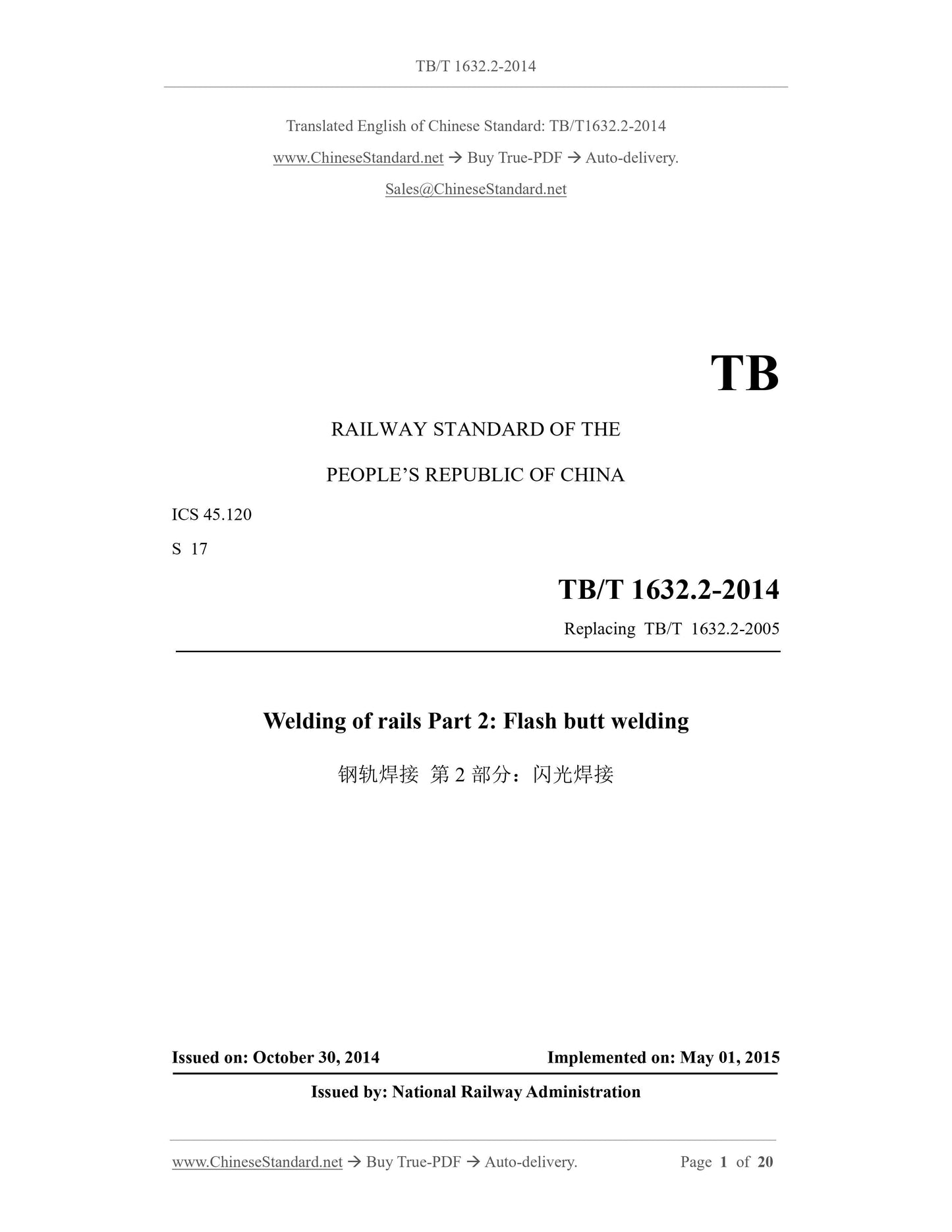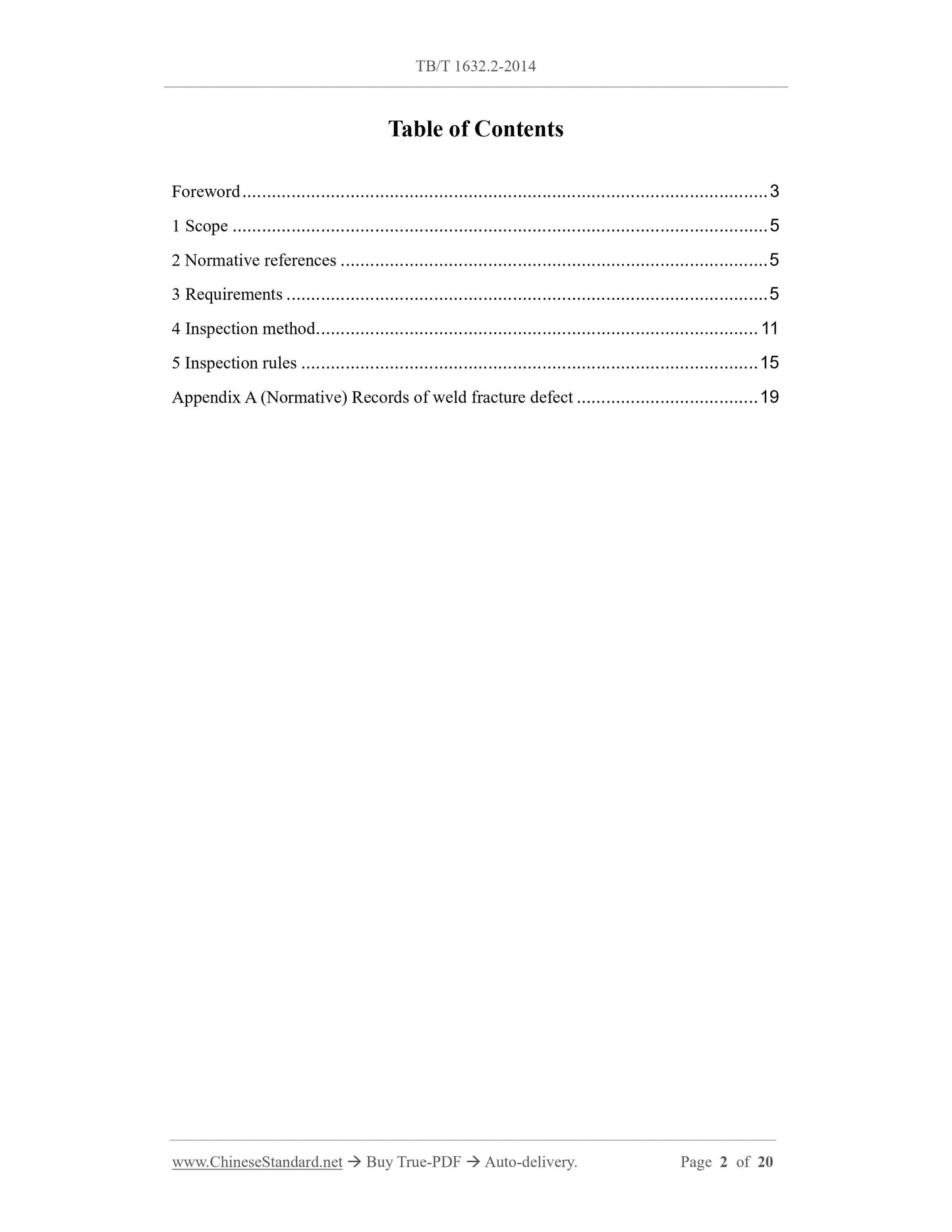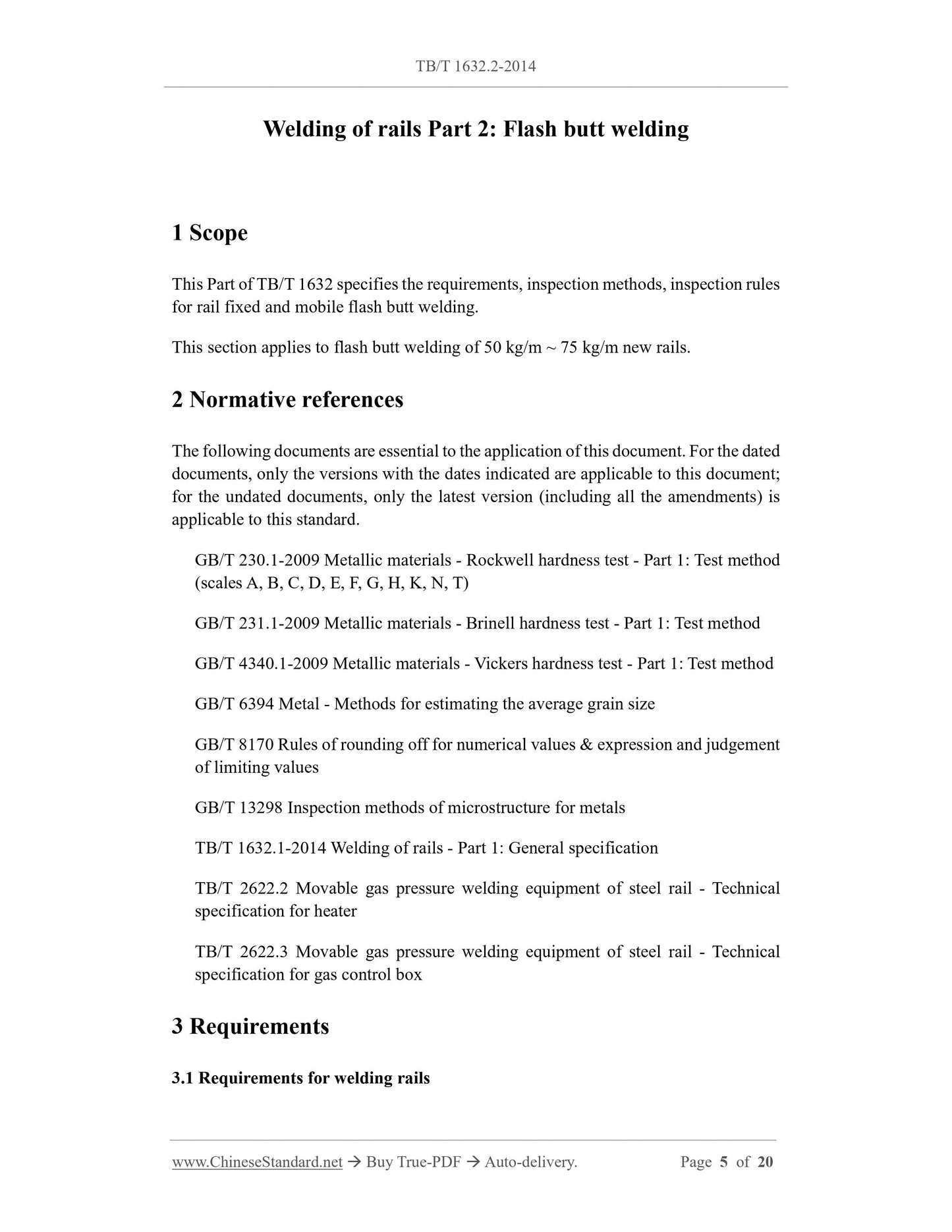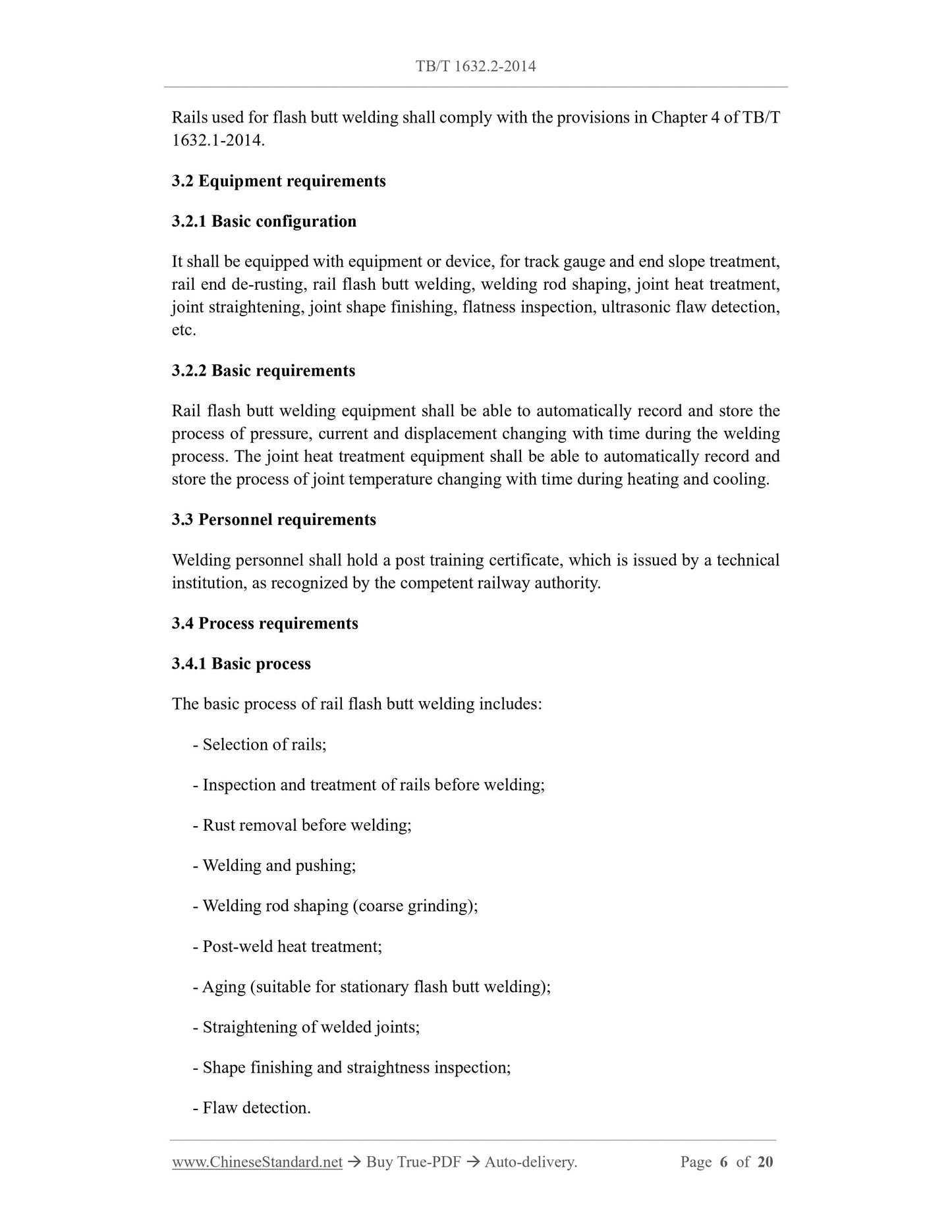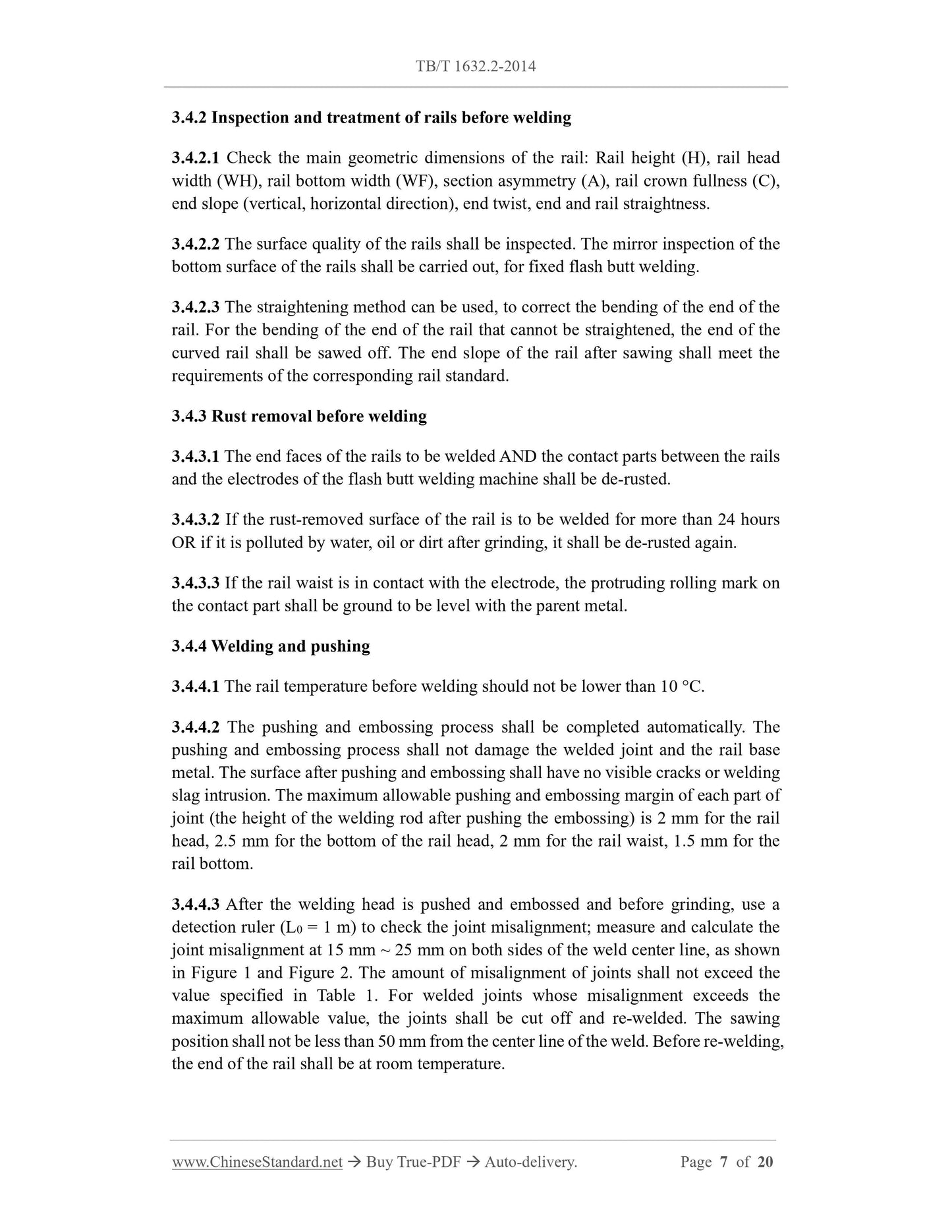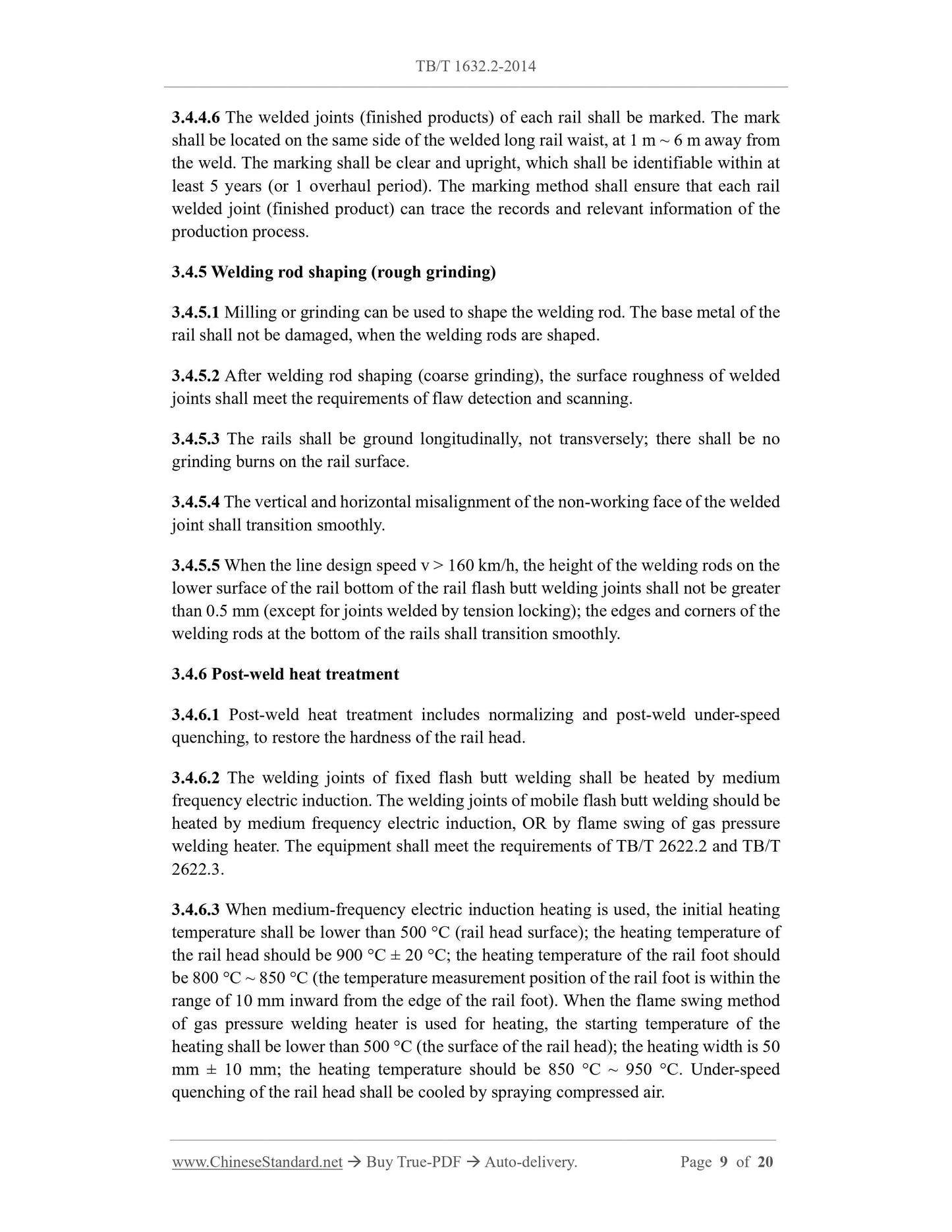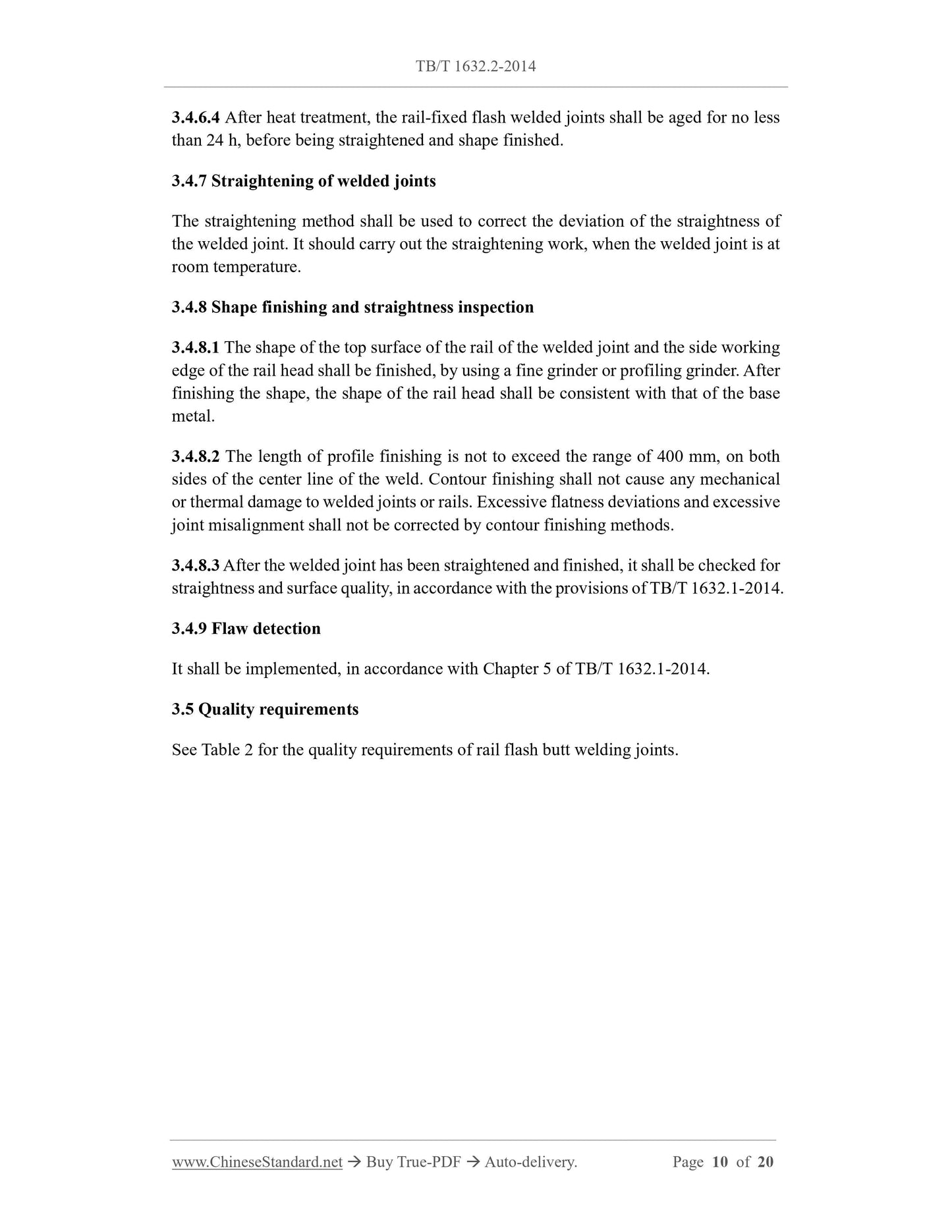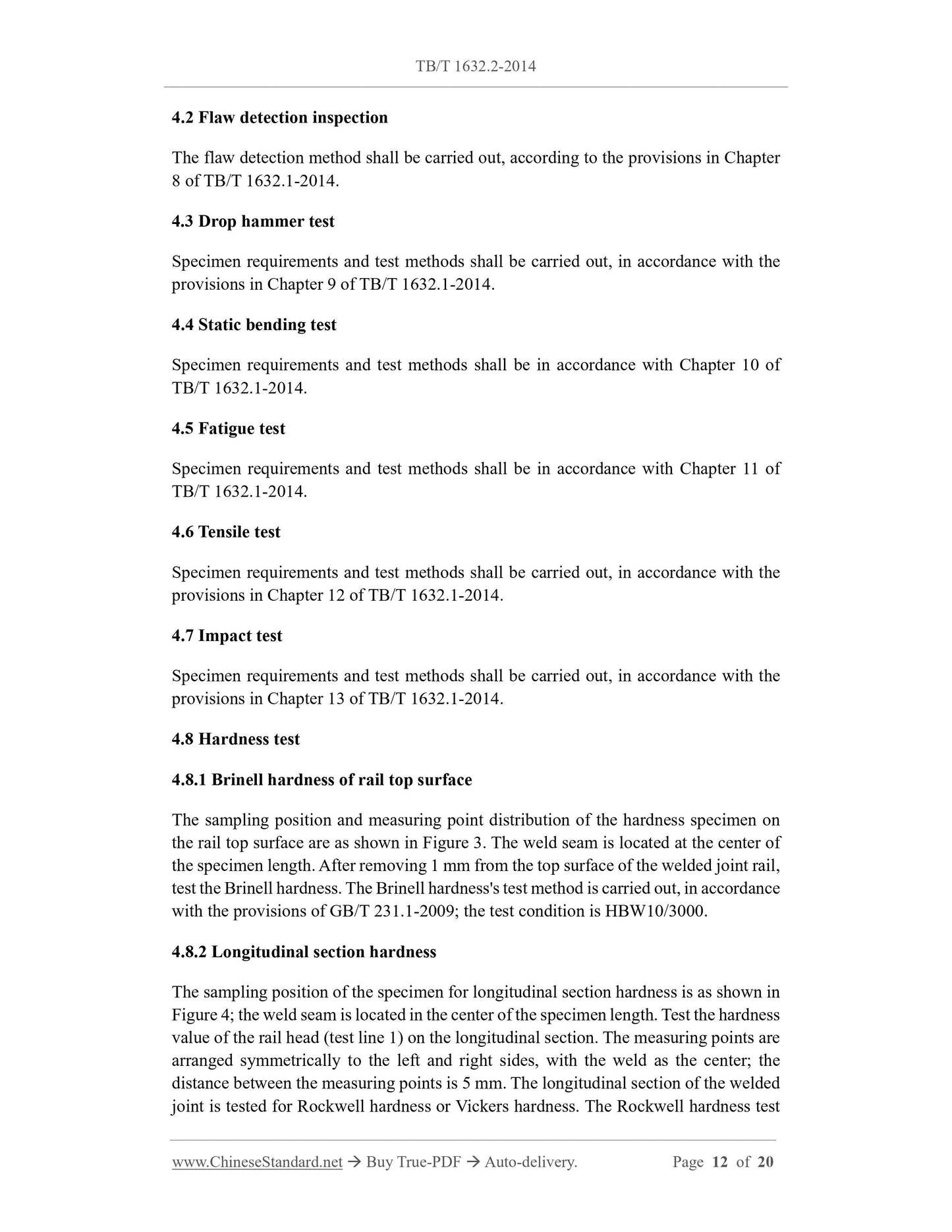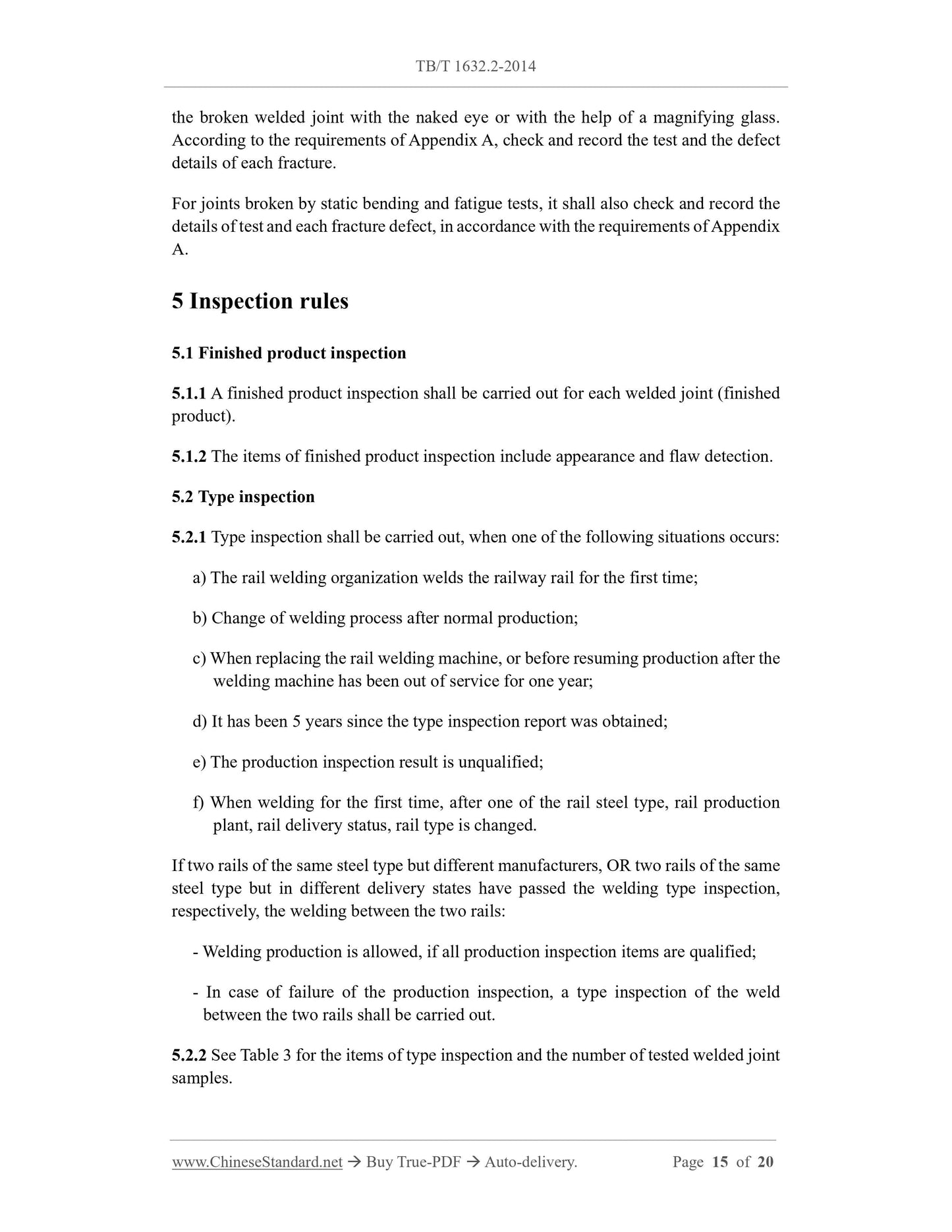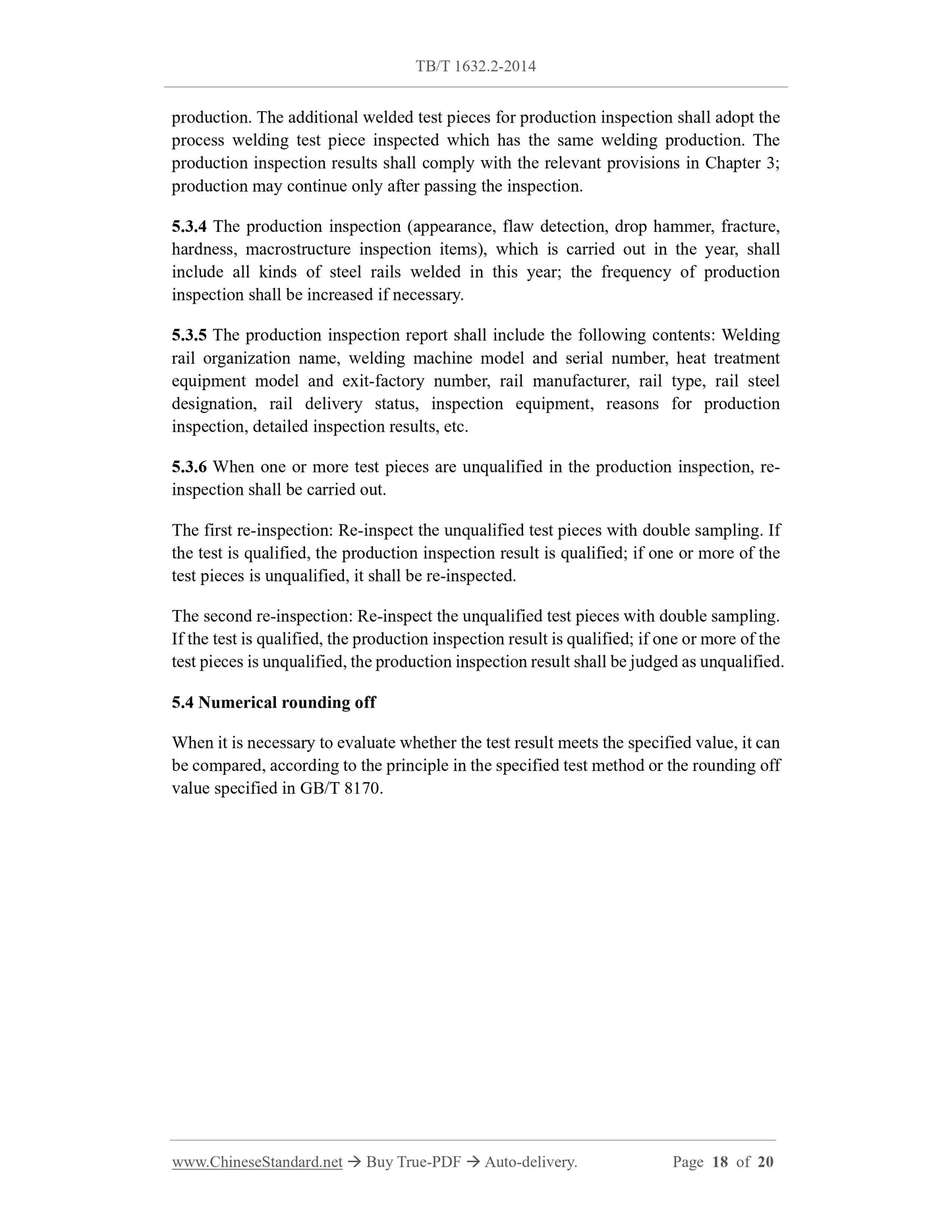1
/
of
10
PayPal, credit cards. Download editable-PDF & invoice in 1 second!
TB/T 1632.2-2014 English PDF (TBT1632.2-2014)
TB/T 1632.2-2014 English PDF (TBT1632.2-2014)
Regular price
$320.00 USD
Regular price
Sale price
$320.00 USD
Unit price
/
per
Shipping calculated at checkout.
Couldn't load pickup availability
Delivery: 3 seconds. Download true-PDF + Invoice.
Get QUOTATION in 1-minute: Click TB/T 1632.2-2014
Historical versions: TB/T 1632.2-2014
Preview True-PDF (Reload/Scroll if blank)
TB/T 1632.2-2014: Welding of rails. Part 2: Flash butt welding
TB/T 1632.2-2014
TB
RAILWAY STANDARD OF THE
PEOPLE’S REPUBLIC OF CHINA
ICS 45.120
S 17
Replacing TB/T 1632.2-2005
Welding of rails Part 2: Flash butt welding
ISSUED ON: OCTOBER 30, 2014
IMPLEMENTED ON: MAY 01, 2015
Issued by: National Railway Administration
Table of Contents
Foreword ... 3
1 Scope ... 5
2 Normative references ... 5
3 Requirements ... 5
4 Inspection method ... 11
5 Inspection rules ... 15
Appendix A (Normative) Records of weld fracture defect ... 19
Welding of rails Part 2: Flash butt welding
1 Scope
This Part of TB/T 1632 specifies the requirements, inspection methods, inspection rules
for rail fixed and mobile flash butt welding.
This section applies to flash butt welding of 50 kg/m ~ 75 kg/m new rails.
2 Normative references
The following documents are essential to the application of this document. For the dated
documents, only the versions with the dates indicated are applicable to this document;
for the undated documents, only the latest version (including all the amendments) is
applicable to this standard.
GB/T 230.1-2009 Metallic materials - Rockwell hardness test - Part 1: Test method
(scales A, B, C, D, E, F, G, H, K, N, T)
GB/T 231.1-2009 Metallic materials - Brinell hardness test - Part 1: Test method
GB/T 4340.1-2009 Metallic materials - Vickers hardness test - Part 1: Test method
GB/T 6394 Metal - Methods for estimating the average grain size
GB/T 8170 Rules of rounding off for numerical values and expression and judgement
of limiting values
GB/T 13298 Inspection methods of microstructure for metals
TB/T 1632.1-2014 Welding of rails - Part 1: General specification
TB/T 2622.2 Movable gas pressure welding equipment of steel rail - Technical
specification for heater
TB/T 2622.3 Movable gas pressure welding equipment of steel rail - Technical
specification for gas control box
3 Requirements
3.1 Requirements for welding rails
Rails used for flash butt welding shall comply with the provisions in Chapter 4 of TB/T
1632.1-2014.
3.2 Equipment requirements
3.2.1 Basic configuration
It shall be equipped with equipment or device, for track gauge and end slope treatment,
rail end de-rusting, rail flash butt welding, welding rod shaping, joint heat treatment,
joint straightening, joint shape finishing, flatness inspection, ultrasonic flaw detection,
etc.
3.2.2 Basic requirements
Rail flash butt welding equipment shall be able to automatically record and store the
process of pressure, current and displacement changing with time during the welding
process. The joint heat treatment equipment shall be able to automatically record and
store the process of joint temperature changing with time during heating and cooling.
3.3 Personnel requirements
Welding personnel shall hold a post training certificate, which is issued by a technical
institution, as recognized by the competent railway authority.
3.4 Process requirements
3.4.1 Basic process
The basic process of rail flash butt welding includes:
- Selection of rails;
- Inspection and treatment of rails before welding;
- Rust removal before welding;
- Welding and pushing;
- Welding rod shaping (coarse grinding);
- Post-weld heat treatment;
- Aging (suitable for stationary flash butt welding);
- Straightening of welded joints;
- Shape finishing and straightness inspection;
- Flaw detection.
3.4.2 Inspection and treatment of rails before welding
3.4.2.1 Check the main geometric dimensions of the rail: Rail height (H), rail head
width (WH), rail bottom width (WF), section asymmetry (A), rail crown fullness (C),
end slope (vertical, horizontal direction), end twist, end and rail straightness.
3.4.2.2 The surface quality of the rails shall be inspected. The mirror inspection of the
bottom surface of the rails shall be carried out, for fixed flash butt welding.
3.4.2.3 The straightening method can be used, to correct the bending of the end of the
rail. For the bending of the end of the rail that cannot be straightened, the end of the
curved rail shall be sawed off. The end slope of the rail after sawing shall meet the
requirements of the corresponding rail standard.
3.4.3 Rust removal before welding
3.4.3.1 The end faces of the rails to be welded AND the contact parts between the rails
and the electrodes of the flash butt welding machine shall be de-rusted.
3.4.3.2 If the rust-removed surface of the rail is to be welded for more than 24 hours
OR if it is polluted by water, oil or dirt after grinding, it shall be de-rusted again.
3.4.3.3 If the rail waist is in contact with the electrode, the protruding rolling mark on
the contact part shall be ground to be level with the parent metal.
3.4.4 Welding and pushing
3.4.4.1 The rail temperature before welding should not be lower than 10 °C.
3.4.4.2 The pushing and embossing process shall be completed automatically. The
pushing and embossing process shall not damage the welded joint and the rail base
metal. The surface after pushing and embossing shall have no visible cracks or welding
slag intrusion. The maximum allowable pushing and embossing margin of each part of
joint (the height of the welding rod after pushing the embossing) is 2 mm for the rail
head, 2.5 mm for the bottom of the rail head, 2 mm for the rail waist, 1.5 mm for the
rail bottom.
3.4.4.3 After the welding head is pushed and embossed and before grinding, use a
detection ruler (L0 = 1 m) to check the joint misalignment; measure and calculate the
joint misalignment at 15 mm ~ 25 mm on both sides of the weld center line, as shown
in Figure 1 and Figure 2. The amount of misalignment of joints shall not exceed the
value specified in Table 1. For welded joints whose misalignment exceeds the
maximum allowable value, the joints shall be cut off and re-welded. The sawing
position shall not be less than 50 mm from the center line of the weld. Before re-welding,
the end of the rail shall be at room temperature.
3.4.4.6 The welded joints (finished products) of each rail shall be marked. The mark
shall be located on the same side of the welded long rail waist, at 1 m ~ 6 m away from
the weld. The marking shall be clear and upright, which shall be identifiable within at
least 5 years (or 1 overhaul period). The marking method shall ensure that each rail
welded joint (finished product) can trace the records and relevant information of the
production process.
3.4.5 Welding rod shaping (rough grinding)
3.4.5.1 Milling or grinding can be used to shape the welding rod. The base metal of the
rail shall not be damaged, when the welding rods are shaped.
3.4.5.2 After welding rod shaping (coarse grinding), the surface roughness of welded
joints shall meet the requirements of flaw detection and scanning.
3.4.5.3 The rails shall be ground longitudinally, not transversely; there shall be no
grinding burns on the rail surface.
3.4.5.4 The vertical and horizontal misalignment of the non-working face of the welded
joint shall transition smoothly.
3.4.5.5 When the line design speed v > 160 km/h, the height of the welding rods on the
lower surface of the rail bottom of the rail flash butt welding joints shall not be greater
than 0.5 mm (except for joints welded by tension locking); the edges and corners of the
welding rods at the bottom of the rails shall transition smoothly.
3.4.6 Post-weld heat treatment
3.4.6.1 Post-weld heat treatment includes normalizing and post-weld under-speed
quenc...
Get QUOTATION in 1-minute: Click TB/T 1632.2-2014
Historical versions: TB/T 1632.2-2014
Preview True-PDF (Reload/Scroll if blank)
TB/T 1632.2-2014: Welding of rails. Part 2: Flash butt welding
TB/T 1632.2-2014
TB
RAILWAY STANDARD OF THE
PEOPLE’S REPUBLIC OF CHINA
ICS 45.120
S 17
Replacing TB/T 1632.2-2005
Welding of rails Part 2: Flash butt welding
ISSUED ON: OCTOBER 30, 2014
IMPLEMENTED ON: MAY 01, 2015
Issued by: National Railway Administration
Table of Contents
Foreword ... 3
1 Scope ... 5
2 Normative references ... 5
3 Requirements ... 5
4 Inspection method ... 11
5 Inspection rules ... 15
Appendix A (Normative) Records of weld fracture defect ... 19
Welding of rails Part 2: Flash butt welding
1 Scope
This Part of TB/T 1632 specifies the requirements, inspection methods, inspection rules
for rail fixed and mobile flash butt welding.
This section applies to flash butt welding of 50 kg/m ~ 75 kg/m new rails.
2 Normative references
The following documents are essential to the application of this document. For the dated
documents, only the versions with the dates indicated are applicable to this document;
for the undated documents, only the latest version (including all the amendments) is
applicable to this standard.
GB/T 230.1-2009 Metallic materials - Rockwell hardness test - Part 1: Test method
(scales A, B, C, D, E, F, G, H, K, N, T)
GB/T 231.1-2009 Metallic materials - Brinell hardness test - Part 1: Test method
GB/T 4340.1-2009 Metallic materials - Vickers hardness test - Part 1: Test method
GB/T 6394 Metal - Methods for estimating the average grain size
GB/T 8170 Rules of rounding off for numerical values and expression and judgement
of limiting values
GB/T 13298 Inspection methods of microstructure for metals
TB/T 1632.1-2014 Welding of rails - Part 1: General specification
TB/T 2622.2 Movable gas pressure welding equipment of steel rail - Technical
specification for heater
TB/T 2622.3 Movable gas pressure welding equipment of steel rail - Technical
specification for gas control box
3 Requirements
3.1 Requirements for welding rails
Rails used for flash butt welding shall comply with the provisions in Chapter 4 of TB/T
1632.1-2014.
3.2 Equipment requirements
3.2.1 Basic configuration
It shall be equipped with equipment or device, for track gauge and end slope treatment,
rail end de-rusting, rail flash butt welding, welding rod shaping, joint heat treatment,
joint straightening, joint shape finishing, flatness inspection, ultrasonic flaw detection,
etc.
3.2.2 Basic requirements
Rail flash butt welding equipment shall be able to automatically record and store the
process of pressure, current and displacement changing with time during the welding
process. The joint heat treatment equipment shall be able to automatically record and
store the process of joint temperature changing with time during heating and cooling.
3.3 Personnel requirements
Welding personnel shall hold a post training certificate, which is issued by a technical
institution, as recognized by the competent railway authority.
3.4 Process requirements
3.4.1 Basic process
The basic process of rail flash butt welding includes:
- Selection of rails;
- Inspection and treatment of rails before welding;
- Rust removal before welding;
- Welding and pushing;
- Welding rod shaping (coarse grinding);
- Post-weld heat treatment;
- Aging (suitable for stationary flash butt welding);
- Straightening of welded joints;
- Shape finishing and straightness inspection;
- Flaw detection.
3.4.2 Inspection and treatment of rails before welding
3.4.2.1 Check the main geometric dimensions of the rail: Rail height (H), rail head
width (WH), rail bottom width (WF), section asymmetry (A), rail crown fullness (C),
end slope (vertical, horizontal direction), end twist, end and rail straightness.
3.4.2.2 The surface quality of the rails shall be inspected. The mirror inspection of the
bottom surface of the rails shall be carried out, for fixed flash butt welding.
3.4.2.3 The straightening method can be used, to correct the bending of the end of the
rail. For the bending of the end of the rail that cannot be straightened, the end of the
curved rail shall be sawed off. The end slope of the rail after sawing shall meet the
requirements of the corresponding rail standard.
3.4.3 Rust removal before welding
3.4.3.1 The end faces of the rails to be welded AND the contact parts between the rails
and the electrodes of the flash butt welding machine shall be de-rusted.
3.4.3.2 If the rust-removed surface of the rail is to be welded for more than 24 hours
OR if it is polluted by water, oil or dirt after grinding, it shall be de-rusted again.
3.4.3.3 If the rail waist is in contact with the electrode, the protruding rolling mark on
the contact part shall be ground to be level with the parent metal.
3.4.4 Welding and pushing
3.4.4.1 The rail temperature before welding should not be lower than 10 °C.
3.4.4.2 The pushing and embossing process shall be completed automatically. The
pushing and embossing process shall not damage the welded joint and the rail base
metal. The surface after pushing and embossing shall have no visible cracks or welding
slag intrusion. The maximum allowable pushing and embossing margin of each part of
joint (the height of the welding rod after pushing the embossing) is 2 mm for the rail
head, 2.5 mm for the bottom of the rail head, 2 mm for the rail waist, 1.5 mm for the
rail bottom.
3.4.4.3 After the welding head is pushed and embossed and before grinding, use a
detection ruler (L0 = 1 m) to check the joint misalignment; measure and calculate the
joint misalignment at 15 mm ~ 25 mm on both sides of the weld center line, as shown
in Figure 1 and Figure 2. The amount of misalignment of joints shall not exceed the
value specified in Table 1. For welded joints whose misalignment exceeds the
maximum allowable value, the joints shall be cut off and re-welded. The sawing
position shall not be less than 50 mm from the center line of the weld. Before re-welding,
the end of the rail shall be at room temperature.
3.4.4.6 The welded joints (finished products) of each rail shall be marked. The mark
shall be located on the same side of the welded long rail waist, at 1 m ~ 6 m away from
the weld. The marking shall be clear and upright, which shall be identifiable within at
least 5 years (or 1 overhaul period). The marking method shall ensure that each rail
welded joint (finished product) can trace the records and relevant information of the
production process.
3.4.5 Welding rod shaping (rough grinding)
3.4.5.1 Milling or grinding can be used to shape the welding rod. The base metal of the
rail shall not be damaged, when the welding rods are shaped.
3.4.5.2 After welding rod shaping (coarse grinding), the surface roughness of welded
joints shall meet the requirements of flaw detection and scanning.
3.4.5.3 The rails shall be ground longitudinally, not transversely; there shall be no
grinding burns on the rail surface.
3.4.5.4 The vertical and horizontal misalignment of the non-working face of the welded
joint shall transition smoothly.
3.4.5.5 When the line design speed v > 160 km/h, the height of the welding rods on the
lower surface of the rail bottom of the rail flash butt welding joints shall not be greater
than 0.5 mm (except for joints welded by tension locking); the edges and corners of the
welding rods at the bottom of the rails shall transition smoothly.
3.4.6 Post-weld heat treatment
3.4.6.1 Post-weld heat treatment includes normalizing and post-weld under-speed
quenc...
Share
